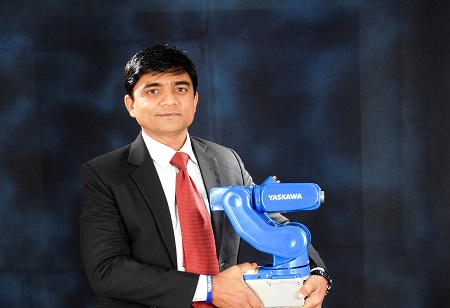In an interaction with Industry Outlook, Ajay Gurjar, Director & COO, Yaskawa India Private Limited, shares his views on the challenges in adoption of industrial robotics and how they can be addressed.
Industrial robots are playing a crucial role in factory automation and the market is expected to grow at a CAGR of more than 14 per cent till 2026. How do you see the current evolution of this market in India? What are the major factors driving its growth?
The Indian
Industrial Automation Market size, which was valued at USD 5 Billion in 2018, is further expected to grow at a CAGR of 12% during 2017-2023 and will reach $4.43 Billion by 2023. As per a survey, there are 74 robotic units per 10,000 employees globally.
The recent developments in
factory automation have led to the growth of the sector. This has also got a boost as the industrial sector is opening up to various technologies that are innovative and cater to the needs of the customers. The leading factor driving its growth is the move towards Industry 4.0.
The articulated robot of traditional industrial robots is expected to hold the largest share of the market, both in terms of value and volume. One will find articulated robots in automotive industry where they are used on a wide scale for various tasks such as welding, assembling, handling, dispensing (gluing and painting), and processing (cutting and polishing) as well as spot welding and painting. In the current scenario, one will also find these robots in high demand in the electronics, pharmaceutical and cosmetic industries. Due to increased demand for COVID-19 testing and production, articulated robots & COBOT can be deployed to achieve seamless automation in the pharmaceutical sector.
What are the major expectations of manufacturers from industrial robotics solution providers? How can those expectations be met comprehensively?
In today’s world, the ways to use a robot have evolved on a large scale. In the early times robots manufacturers used to give one program code and that was used forever. But with the advancement in robotics, each cell is developed in a way that works for every scale. It can make from a car to a cell phone in large quantities. There are five major expectations which we have identified for the manufactures that could help them meet the current needs.
• Flexibility: There should be constant change. Also, the software should be designed in a way that they can be sufficiently open for future changes. This would make the investment of the manufactures future proof.
• Customizable: Each business is different. The software should be designed in a way that it fulfills all the different aspects of varied business.
• Ease of Use: The technology in the machines should be developed in a way that the operators could use it with ease.
• Data Compatibility and Interoperability: As mentioned earlier, with varied business comes variety of expectations. Making standard software with basic and generic function is the best solution.
• Adaptability: With ever increasing demands, the industry demands high adaption rate. The manufactures are expected to make a digital twin that would do the same work of the original machine.
The expectations are very basic but if they are fulfilled in the correct way it could help them take the full advantage of the flexibility and also help in reducing the automation rate.
How is Yaskawa India positioned in this market? What role does it play in bringing about a revolution in manufacturing with robotics?
Coined by Yaskawa, ‘Mechatronics’ is a word being freely used today by everyone. In India, Yaskawa started its journey with the business of PLC in 1980 and AC drives in 1990 and steadily expanded its Robotics applications presence since 2005, to accommodate growing customer needs. Today, our India operations span the length and breadth of the country becoming a central hub for our future goals, which is headed by a vigorous team.
